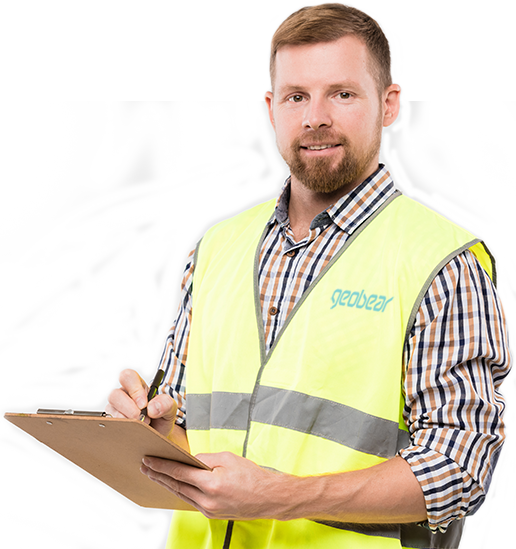Foundation issues are typically a result of loose soils under and around the damaged areas of the foundation. Although piles are commonly used to address foundation issues, they do not actually treat the root cause of the problem.
When a structure, such as a home, sits on soils that are loose, the house may start to sink into the ground. A pile or pier connects to the foundation of the affected structure and can restore stability to it. It does nothing for the soil under and around the structure. This means that the land itself is still compromised. There still may remain voids in which water can infiltrate and cause additional damage or more surface movement.
By addressing the soil instability that is causing the settlement, you are arresting the settlement itself. The use of geopolymer injection essentially treats the root cause while also supporting your foundation – all in a fraction of the time, a fraction of the cost, and a fraction of the hassle. Check out the blog here to learn more about the differences.
Many homeowners are surprised at how much less expensive geopolymer injection can be when compared to traditional pier or pile methods. The biggest variation in cost comes from the total cost of the material, labour, and efficiency of the work.
In traditional pier and pile methods, the pier or pile itself is made of 100% steel. Because steel is a commodity that fluctuates with the market, the cost of steel is a large variable. Often, the raw material cost is then marked up several times before it gets to your property.
Due to the nature of pile or pier repairs, several large holes must be dug around the property, adding substantially more labour hours to the completion of the project. When comparing the two options, these holes also add to your overall costs when you consider repair of landscaping, pavers, irrigation lines, concrete pads, or other areas around the home affected by this construction.
Lastly, our proven innovative technology makes the work more efficient. We do not require expensive raw materials, days of labor from multiple team members, extensive equipment and machine operators, or multiple days on our job sites. Most of our projects can be completed in as little as one or two days, allowing us to pass the savings to our customers.
Our team of engineers and geopolymer injection experts design a customised plan for your specific property. Based on this plan, a technician drills quarter-sized holes in the ground at designated locations throughout your problem area, targeting the weak soil. The geopolymer solution is injected into the ground in liquid form at various depths.
The geopolymer follows the path of least resistance, traveling through loose soils and voids. After a short time, the geopolymer begins to expand with immense pressure. The technician monitors the expansion time and pressure closely, controlling the process to the engineer’s specifications.
The expansion causes loose soils to be compacted and voids to be filled. In some soil types, it acts like a glue – holding soil together in a matrix and restoring the load bearing capacity or strength to the ground. It fills voids, tightens loose soil, and restores the soil’s ability to hold up a structure. For more information on the process, visit our blog here or check out the video available on our website.
There are three additional services typically required for your repair project. We regularly work with contractors in these fields and are happy to recommend specialists. You are also free to find your own. All three of these services are required to protect you and your property.
Engineering Soil Investigation
The first requirement is an engineering soil report. Virtually all contractors addressing your foundation or settlement issue will need some type of soil report conducted by a qualified geotechnical engineer. Because no one can see below the ground, this report allows your provider to understand what is beneath the surface. A soil report is like getting a CT scan from a doctor. It removes the guessing game. You should beware of any contractor that does not require this as you could possibly be paying for a misdiagnosed repair.
Utility Locator
The second required service is a utility locator contractor. This is how we know what utility lines are in the ground, where they are, and, more importantly, how to avoid hitting them. Without this service, one could potentially cause serious damage to your property and our personnel.
CCTV Drain Scan
Lastly, we require a CCTV drain scan. This is where a plumber runs a camera in your drain lines to detect any weakness or breaks in your system. These cracks or other weaknesses could allow the geopolymer to infiltrate your system and cause damage to your home. If a defect is detected, we allow you time to make the necessary repairs. This prevents damage to your property. Once repairs are made, we’ll reschedule and complete the job.
Our process is generally more efficient than many other repair methods. Our injection method requires a series of holes about ¾” in diameter around the perimeter of your affected area where 14mm tubes are driven down to the desired depth(s). After the geopolymer solution is injected, it can cure to 90% of its strength within 15 minutes. Because of this efficient and non-invasive process, we save time and so do you.
Engineers will review the data collected during our investigation to design a plan to stabilise the affected area on your property. Preventing further settlement is always our primary goal and most clients are concerned with stabilising their property first and foremost. Many homeowners choose to focus on stabilising their home versus stabilise and lift the property because of the inherent risk of damage to utility lines. Although such damage is rare, it is still possible and can be very costly.
When stabilising a structure, some lift can be achieved due to the expansive nature of geopolymer. Although we can estimate, there is no way to know in advance how much lift will be achieved until the process is started. The level of lift will depend on the density of the soils and ground. If additional lift is desired, we can allocate additional polymers to the area.
Geopolymer permanently repairs compromised soils. A soil repair can last indefinitely in the right circumstances. It’s important to remove or repair whatever condition caused the issue to begin with. For example, a broken pipe may have caused a water leak that washed out soil under your home’s foundation. While a geopolymer treatment can repair these soils and immediately stop the settlement, new erosion may occur if the leak is not repaired. No contractor will promise that a structure will never move. The longevity of the repair is ultimately up to you. If you’re concerned about longevity, our team is happy to educate you about how to minimise your risk of future settlement, subsidence, and erosion events.
Please use this contact form and will respond to you within 2 working days.
We will provide you with a free site assessment, either online or in person.
We deliver projects on any sort of building or structure – from residential properties, conservatory extension to problems to 80,000m2 warehouses and road infrastructure. In most cases we will have the best solution, so get in touch today.


All terms of use are certified. Copyright. Geobear 2023.